The Krugerrand highlighted the need for private citizens to take ownership of their own gold bullion. Individuals revealed an appetite for gold. The Krugerrand was dominating the gold market and South Africa was not shy to produce gold from its deep mines. The Krugerrand had a good run from 1967, as the first pure gold bullion coin that has been minted in the world.
Other countries noticed the success of the Krugerrand coin. It was just a matter of time before these countries started to mint their own gold bullion coin. In 1979 Canada entered the gold “bullion race” by issuing the Canadian Maple Leaf gold coin. The Canadian Maple Leaf gold coin was the Krugerrand’s first major rival and the world’s first 24-carat bullion coin.
Canadian Maple Leaf gold coin sets the purity content high.
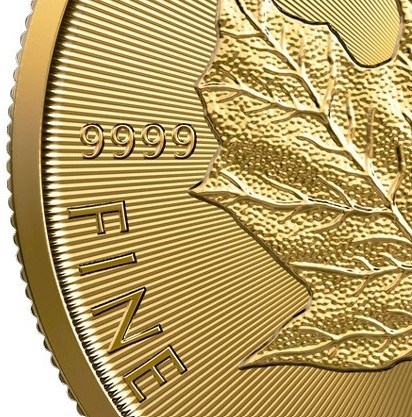
Both the Maple Leaf and the Krugerrand contain one ounce (1oz) of gold. The Royal Canadian Mint distinguished their coin by increasing the purity to 99.9% pure gold compared to the 91.67% gold purity of the Krugerrand. This purer gold content displayed on the coin as 999 was well-received especially by Japan who was the biggest buyers of the Maple Leaf. By 1984 the Maple Leaf held 45% of the Japanese gold market.
Experts argued that the Maple Leaf was softer due to the increased gold content and therefore more prone to damage and wear. Their biggest competitor the Krugerrand contained 8.33% copper alloy.
The Royal Canadian Mint started to produce .9999 pure fine gold Maple Leafs from November 1982. This established the Canadian Maple Leaf gold coin as the purest gold coin in the world. The purity of the Maple leaf was increased even further when the first bullion coin to contain 1 ounce of .99999 fine gold was issued.
The refining process delivering coins of 99.99% (24 carats) purity is backed by a guarantee from the Canadian Government regarding the coin’s weight and purity.
Krugerrand’s fall from grace.
Resistance against the South African government grew in the 1970s and 80s due to their apartheid policies. The Krugerrand’s popularity dwindled as the world skittish away from doing business with South Africa. Many countries instituting an all-out ban of the Krugerrand. By 1984 the stage was set to dethrone the Krugerrand from its stronghold on the gold bullion market. The Maple Leaf had has taken 25 percent of the gold bullion coin market in only 5 years from 1979. To date, more than 39 million gold Maple Leafs have been minted. – Goldbarsworldwide.com. This makes it the second most popular gold bullion coin in the world after the Krugerrand.
The progressiveness of the Maple Leaf gold coin.

Something that comes to mind when studying the Maple Leaf is the progressiveness of how the Royal Canadian Mint and the coin developed over the years to remain competitive in the gold market.
The Royal Canadian Mint uses advanced minting techniques to offer a wide variety of finishes like a “bullion finish” that has a brilliant finish against a backdrop of parallel lines that reflect light in a brilliant way. Other strategies developed by the Royal Canadian Mint to maintain its competitive advantage were:
- In 1999 the first colored coins were produced by the mint.
- Also in 1999 the first coin to feature a hologram.
- In 2007 the purest gold bullion coin ever made, a 1 oz gold coin with a gold purity of 99.999% were issued.
- In May 2007 a Gold Maple Leaf coin with a face value of $1 million was issued. This coin weighed a 100kg (3,215 oz), with a diameter of 50cm and 99.999% gold purity – sharpspixley.
- In 2012 the Five Hundred Dollar Coin was minted. This 5-ounce coin was struck with 99.99% gold purity.
The most secure coin in the world
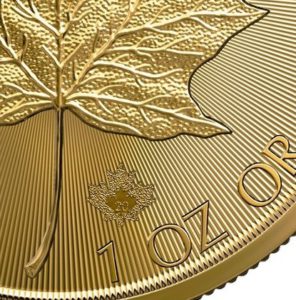
The Canadian Maple Leaf gold coin is known as the most secure coin in the world with enhanced security features that make counterfeiting extremely difficult to impossible. These security features that you can expect from the Maple Leaf makes buying the coin a less stressful experience as the buyer is assured that he is getting an authenticated coin. The most important security features are:
- The radial lines that originate from the center of the coin are struck with micron-precision.
- Laser technology is being used to micro-engrave the textured maple leaf at the back of the coin.
- Digital non-destructive activation (DNA) technology captures images encrypted with a string of codes and stores these in a secure database. Investors can confirm the authentication of the coin instantly with the Royal Canadian Mint’s registry.
Product details of the standard 1 oz Gold Maple Leaf coin
- Gold content – 1 oz (Troy ounce).
- Gold purity – 99.99% (24 carats).
- Weight – 31.15 gram.
- Diameter – 30 millimeters.
- Thickness – 2.87 millimeters.
- Face value – C$50 fully backed by the government of Canada.
- Mint – Royal Canadian Mint
The Gold Maple Leaf’s Features
The Maple Leaf is a very recognizable coin, presenting the maple leaf which is the national symbol of Canada. The Maple Leaf gold coin blends historical significance with precise details, security and consistency in production. Every aspect of this coin boasts of quality and precision through technology.
The obverse of the Gold Maple Leaf
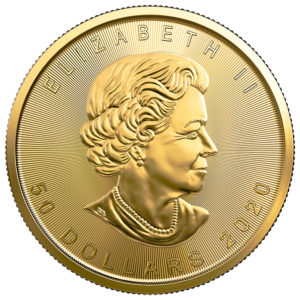
The obverse portray the bust of Her Majesty Queen Elizabeth II in a classic right-facing portrait. The design is changed as she had aged. They offer 3 different versions of Queen Elizabeth II depending on the years issued.
- From 1979 to 1989 the Queen is showed as she was at 39 years of age. Designed by Arnold Machin.
- From 1989 to 2003 the Queen is displayed in her 64th year. Designed by Dora de pédery-hunt
- From 2005 to date her profile is as she was at 79 years old. Designed by Susanna Blunt.
At the top curve the words “ELIZABETH II”.
At the bottom is displayed the face value of the coin $50 CAD and the year it was minted.
The reverse of the Gold Maple Leaf
The maple tree that bears the leaves has become the most prominent Canadian symbol nationally and internationally. The maple tree contributes valuable wood products, sustain the maple industry and help to beautify the landscape of Canada. It has contributed to the historical, commercial, environmental and aesthetic development of Canada. Since 1965 the maple leaf has been the centerpiece of the National Flag of Canada.
The coins produced by the Royal Canadian Mint are officially known as Maple Leafs since 1979. The reverse of the Canadian Maple Leaf gold coin features the maple leaf symbol of Canada.
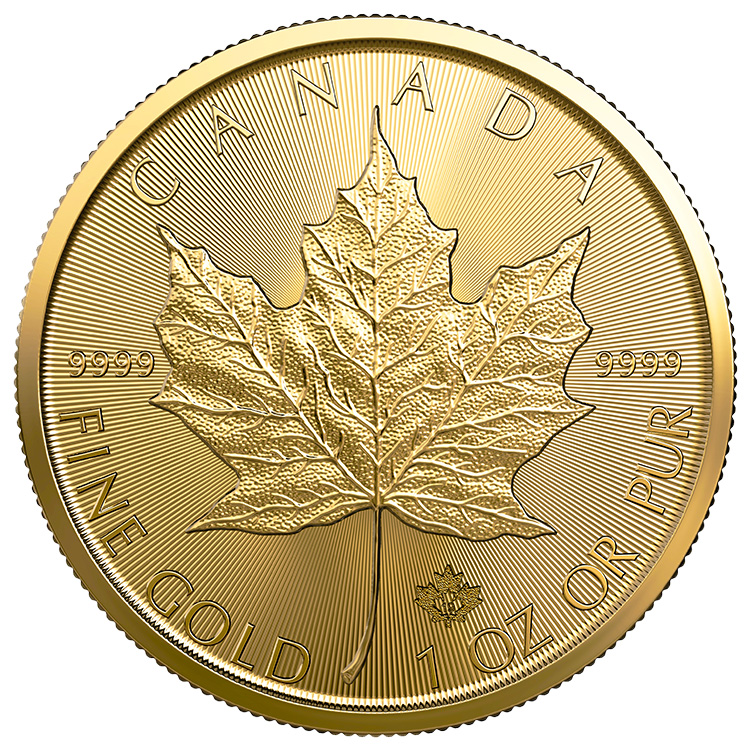
At the top arcs the word “Canada”.
At the bottom of the coin the specifications of the coin in both English and French “FINE GOLD 1 OZ OR PUR”
A laser mark micro-engraving maple leaf on the coins since 2013. Etched within the center of the maple leaf are two digits indicating the coin’s production year, which is only visible under magnification.
The gold purity is recorded twice on each side of the maple leaf as “999” for coins between 1979-1982 and “9999” for coins from 1983 onwards.
Radial lines that are precisely machined within microns replaced the traditional bullion finish. The lines width and pitch create a light-diffracting patten specific to each coin.
Range
The Maple Leaf gold coin is available in 5 standard sizes:
- 1 oz
- ½ oz
- ¼ oz
- 1/10 oz
- 1/20 oz
Pros of the Canadian Maple Leaf gold coin
-
-
Purity.
The Gold Maple Leaf is one of the purest gold coins available with a gold purity of at least 99.9%. It is also the first bullion coin to be minted in 24 carats of gold purity.
-
Backed by the Canadian government.
The coin carries a face value of CA$50 and under the Canadian Currency Act of 1985 is a legal tender backed by the Canadian government.
-
Security.
The security features are unprecedented and provide the most powerful defense against counterfeit reproduction. An added layer of security with digital non-destructive activation (DNA) technology to verify the authenticity of the Maple Leaf against the Royal Canadian Mint Registry assures that only genuine coins are traded. Each coin’s weight and purity are concurrently guaranteed by the mint and the Canadian government.
-
Beautiful recognizable design.
The Maple Leaf design is an iconic, attractive and worldwide recognizable coin. The original maple leaf design has remained relatively unaltered since its original appearance. The radial lines emanating from the background in a light-diffracting pattern is a beautiful artistic addition.
-
Traded at low premiums
The Royal Canadian Mint adjusts its prices to the market changes more easily and the premium on the Maple Leaf gold coin is generally 4%-5%.
-
International distribution
The coin is promoted worldwide and distributed internationally in the major gold markets and distribution centers in the world.
-
Popularity
As the second most traded gold bullion coin in the world, it is a firm favorite among investors and collectors. This results in an inactive market where there are a number of buyers that will buy the Canadian Maple Leaf gold coin.
-
Lower import taxes
In certain countries, higher import taxes are levied on lower-purity gold coins like the 22k Krugerrand coin compared to the 24k gold coins. This is an important consideration when planning to ship and store coins internationally.
-
Cons of the Canadian Maple Leaf gold coin
There are not many cons with owning Maple Leaf coins. The most known cons are:
-
-
Softness
A standard problem with pure gold is that it easily shows handling marks and it is prone to damage.
-
Production Quality
Some dealers have complained about the production quality and storage provided of the Gold Maple Leafs which are housed in tubes. The clear fields around the Queen and the milled edge are prone to damage.
-
Not a legal currency
The coin is not a legal currency in countries outside of Canada which means that investing in these coins will incur Capital Gains Tax. The face value of C$ 50 is confusing because the coin is trading at values much higher than the face value. The fiat value when compared to the commodity value of gold is continuing to expand with inflation which makes the face value irrelevant.
-
Conclusion
The Canadian Maple Leaf gold coin is a prestigious coin. The coin that is exclusively produced from gold has little competition in terms of purity, quality and security. Experienced coin bullion investors have found value with investing in a coin that has a history of over 4 decades. The timeless design along with its security features makes the investment in gold bullion very simple for first-time investors. In my opinion, the Canadian Maple Leaf gold coin must be considered when investing in gold bullion.
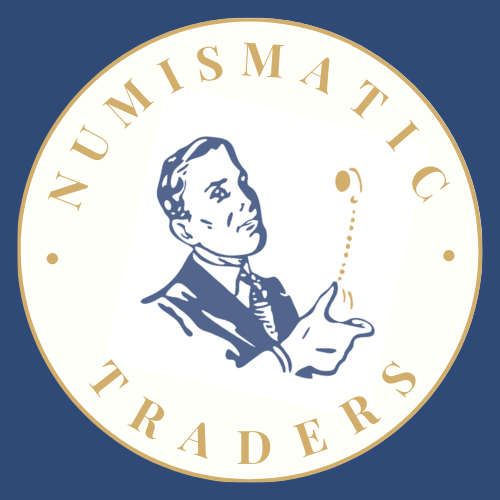
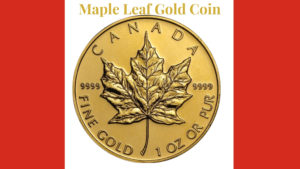


Well, this seems to me like a really good gold coin. Never heard of it before though but I have learnt that investing in gold can turn out to be very lucrative which is something that I am looking to go into. I’m happy you could give the details about this Canadian maple leaf coin. Thanks!
The Canadian Maple Leag Gold coin is certainly one of the best gold coins available. It stands out in terms of purity which is very popular in Eastern Countries. The trade-off for purity is prone to damage, which can severely drop a coin’s value if it happens. The other outstanding feature of the Canadian Maple Leaf gold coin is its security features which unparalleled in the market.
Gold is a hedge against risk from the currencies and stock market fluctuations. Gold is inversely correlated with these two “assets” which means if shares fall, the gold price goes up, When confidence in the stock market returns money is channeled from other asset classes like gold into the stock market and the price of gold drops. I include gold in my portfolio as protection against these risks.
Hello there, it’s really amazing sight this coin has and one thing I really like about it is the advantages that seem really good and not every goal coin I have seen has all of the benefits actually. This is the first time I’m seeing it and I can actually assume how valuable it is. I look forward to investing in gold.
Hi Justin you are right. Seeing these coins in real life is just next level. Unfortunately, the pictures don’t do them justice. Especially the proof coins with its brilliant shine.
Just a word of caution to compare the premium that you pay above the gold spot price for certain gold bullion coins. When serious investors are seeking bullion, they disregard certain qualities inherent in certain gold bullion coins.
When I was reading I was trying to figure out whether I would prefer a coin that is almost entirely gold, but possibly prone to damage. Or whether I would rather have a coin that is approx 91% gold, the rest copper alloy, and less prone to damage. I guess the more gold the coin has the better, but you obviously need to make sure you look after it. It is also reassuring to know that this coin is less likely to become victim to counterfeiting. The security features sound really awesome and cutting edge. The design of the coin is also beautiful with incredible detail.
Ray that is exactly the trade-off, keeping in mind that the coins that contain alloy copper like the Krugerrand, plus 3% silver like the American Eagle Gold coin still have 1 ounce gold which makes the coin heavier.
The Royal Canadian Mint certainly know their competitive advantage and they are “coining it”
I assume it comes down to personal taste and what is available at what price when you are ready to buy. I believe in diversification because each bullion coin has a unique characteristic that makes it appealing (nearly like humans). My strategy is to try and get them all.
Thanks for sharing this article about the Canadian maple leaf God coin, this is actually the very first time I’m reading about it has I find it really interesting to do so. I like he fcat that the coin a lot of value in small piece and it is quite expensive and precious too. How does rise and drop in value of dollars affects?
Hi Bruce excellent question. Gold and silver are inversely correlated to the value of the dollar. The value of currencies like the dollar is measured by the rate of inflation (REAL inflation) and the money supply issued by “Reserve Banks” like the federal reserve. Due to the fact that Gold and Silver have limited supplies that cannot be grossly manipulated in general, it acts as a hedge against inflation and the devaluation of currencies. As currencies devalue, the price of Gold and Silver increases. I am sure you are aware of the current expansion of money supply by the Federal Reserve in an attempt to “save” the economy. A large amount of this money supply ended up in the “Stock market”.
In order to balance an investment portfolio, and to use a safety net, gold and silver should be included because the precious market reacts in the opposite of the stock market and other asset classes.
Private individuals still need to be cautious of the Gold and Silver market because the spot price is based on future contracts which are influenced by the Big Roleplayers such as banks. For example, a person new to the precious metal market will experience anxiety because of the 10% drop in the prices of gold and silver in the past week, while others know this drop is a result of the Big banks closing their short deals to reduce their losses before the month-end.
At Numismatic Traders, we focus on the fundamentals of coins, the precious market and the economy in general and not so much on trading. Short trading can be extremely challenging and result in irrecoverable losses.